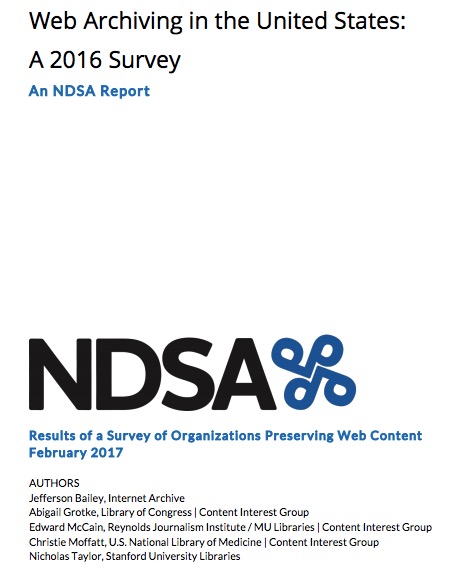National Digital Stewardship Alliance (NSDA) Releases 2016 Web Archiving Survey Report and Dataset
From the Digital Library Federation:
The National Digital Stewardship Alliance is pleased to announce the release of the 2016 Web Archiving Survey Report..
From January 20 to February 16, 2016, a team representing multiple NDSA member institutions and interest groups conducted a survey of organizations in the United States actively involved in, or planning to start, programs to archive content from the Web. This effort built upon a similar survey undertaken by NDSA in late 2011 and published online in June 2012 and a second survey in late 2013 published online in September 2014.
[Clip]
A few major takeaways from the report include:
- More programs are moving from pilot to production (79% of respondents classified their status as production; only 5% as pilot)
- There are increased perceptions of progress over past 2 years (77% respondents reported that their program had made either significant or some progress over the past two years.)
- The top 3 areas where organizations have made the most progress are: data capture, appraisal and selection, and vision and objectives
- The top 3 areas where organizations have made the least progress are: access/use/reuse, metadata/description, and quality assurance and analysis
- The number of respondents who are transferring their Web archive data from an external service (such as Archive-It) remains low at ~20%
- Staffing levels for web archiving remain low: 76% (64 of 84) of organizations are devoting less than the equivalent of one fulltime employee’s (FTE) time to web archiving
- The top three staff skills essential to development and success of programs: facility with archiving tools, skills for appraisal and selection, skills for performing quality assurance
And finally, the report reveals a growing trend seen across the reports that shows a significant interest in collaboration on a number of and finally, the report reveals a growing trend seen across the reports that shows a significant interest in collaboration on a number of fronts.
Read the Complete Blog Post
Direct to Full Text Report (32 pages; PDF)
Direct to Survey Questions (18 pages; PDF)
Direct to Survey Dataset (via Dataverse)
Filed under: Associations and Organizations, Data Files, Digital Collections, Interactive Tools, Libraries, News, Reports
About Gary Price
Gary Price (gprice@gmail.com) is a librarian, writer, consultant, and frequent conference speaker based in the Washington D.C. metro area. He earned his MLIS degree from Wayne State University in Detroit. Price has won several awards including the SLA Innovations in Technology Award and Alumnus of the Year from the Wayne St. University Library and Information Science Program. From 2006-2009 he was Director of Online Information Services at Ask.com.



